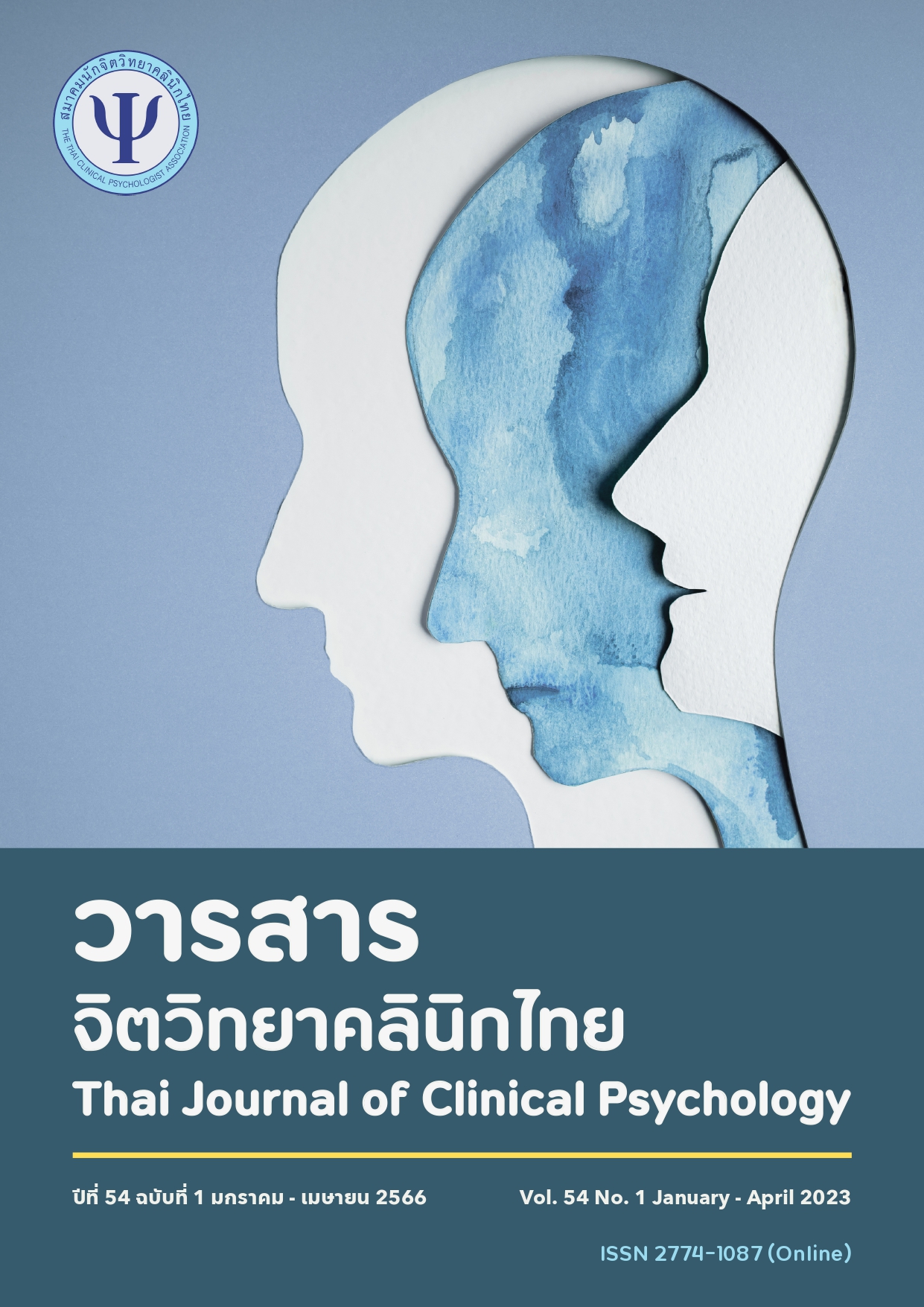ความยากลำบากในการกำกับอารมณ์และปัญหาจากการดื่มแอลกอฮอล์ของนักศึกษาปริญญาตรี: บทบาทของแรงจูงใจในการดื่มในฐานะตัวแปรส่งผ่าน
Main Article Content
บทคัดย่อ
วัตถุประสงค์ เพื่อพัฒนาและตรวจสอบความตรงของแบบจำลองความสัมพันธ์ระหว่างความยากลำบากในการกำกับอารมณ์และปัญหาจากการดื่มแอลกอฮอล์ของนักศึกษาที่มีแรงจูงใจในการดื่มเป็นตัวแปรส่งผ่าน วัสดุและวิธีการ การวิจัยเป็นการวิจัยเชิงสหสัมพันธ์ เก็บข้อมูลด้วยแบบสอบถามได้แก่ 1) แบบสอบถามข้อมูลทั่วไป 2) แบบสอบถามความยากลำบากในการกำกับอารมณ์ 3) แบบสอบถามแรงจูงใจในการดื่ม และ 4) แบบสอบถามปัญหาจากการดื่มแอลกอฮอล์ของนักศึกษา จากนักศึกษาระดับปริญญาตรีจำนวน 385 คน ที่อายุตั้งแต่ 18 ปีขึ้นไป และเคยดื่มแอลกอฮอล์ในช่วง 12 เดือนที่ผ่านมา ผล แบบจำลองสมมุติฐานมีความสอดคล้องกับข้อมูลเชิงประจักษ์ดี (𝜒2= .028, df = 1, p = .867, 𝜒2/𝑑𝑓 = .028, RMSEA < .001, CFI = 1.000, TLI = 1.000, SRMR = .001) การวิเคราะห์เส้นทางอิทธิพลพบว่า 1) ความยากลำบากในการกำกับอารมณ์มีอิทธิพลทางตรงกับแรงจูงใจในการดื่มทั้ง 4 ด้านได้แก่ แรงจูงใจในการดื่มเพื่อเพิ่มอารมณ์เชิงบวก แรงจูงใจในการดื่มเพื่อลืมปัญหา แรงจูงใจในการดื่มเพื่อเข้าสังคม และแรงจูงใจในการดื่มแบบคล้อยตาม 2) แรงจูงใจในการดื่มเพื่อลืมปัญหาและแรงจูงใจในการดื่มเพื่อเพิ่มอารมณ์เชิงบวกมีอิทธิพลทางตรงกับปัญหาจากการดื่มแอลกอฮอล์และ 3) ความยากลำบากในการกำกับอารมณ์กับปัญหาจากการดื่มแอลกอฮอล์มีความสัมพันธ์ผ่านแรงจูงใจในการดื่มเพื่อลืมปัญหา (TE = .122) และแรงจูงใจในการดื่มเพื่อเพิ่มอารมณ์ทางบวก (TE = .029) สรุป แรงจูงใจในการดื่มเพื่อเพิ่มอารมณ์ทางบวกและแรงจูงใจในการดื่มเพื่อลืมปัญหาเป็นตัวแปรส่งผ่านที่เชื่อมโยงความยากลำบากในการกำกับอารมณ์กับปัญหาจากการดื่มแอลกอฮอล์ในนักศึกษา
Article Details

อนุญาตภายใต้เงื่อนไข Creative Commons Attribution-NonCommercial-NoDerivatives 4.0 International License.
เรื่องที่ลงตีพิมพ์ในวารสารจิตวิทยาคลินิกแล้วถือเป็นลิขสิทธิ์การเผยแพร่โดยวารสารจิตวิทยาคลินิกแต่เพียงผู้เดียว การตีพิมพ์หรือเผยแพร่ซ้ำในที่อื่นต้องได้รับอนุญาตจากกองบรรณาธิการวารสารฯ
เอกสารอ้างอิง
Aurora, P. & Klanecky, A. K. (2016). Drinking motives mediate emotion regulation difficulties and problem drinking in college students. The American Journal of Drug and Alcohol Abuse, 42(3), 341-350. https://doi.org/10.3109/00952990.2015.1133633.
Bresin. K., & Mekawi, Y. (2021). The "Why" of drinking matters: A meta-analysis of the association between drinking motives and drinking outcomes. Alcoholism: Clinical and Experimental Research, 45(1), 38-50. https://doi.org/10.1111/acer.14518.
Brister, H. A. (2012). Increasing emotion regulation skills for the reduction of heavy drinking [Doctoral dissertation, The University of Texas at Austin]. The University of Texas at Austin Repository. http://hdl.handle.net/2152/19476.
Buckner, J. D., Lewis, E. M., Abarno, C. N., Morris, P. E., Glover, N. I. & Zvolenksy, M. J. (2021). Difficulties with emotion regulation and drinking during the COVID-19 pandemic among undergraduates: The serial mediation of COVID-related distress and drinking to cope with the pandemic. Cognitive Behavioural Therapy, 50(4), 261-275. https://doi.org/10.1080/16506073.2020.1861084
Bureau of Health Promotion. (2019). Negative effects of alcohol and health consequences toward self and others. Bureau of Health Promotion, Department of Health. (in Thai).
Center for Alcohol Studies. (2022). Patterns and trends of drinking behaviors among Thai population: Center for Alcohol Studies. (in Thai).
Center for Behavioral Health Statistics and Quality. (2015). Behavioral health trends in the United States: Results from the 2014 National Survey on Drug Use and Health (No. SMA15-4927). Department of Health & Human Services. https://www.samhsa.gov/data/sites/default/files/NSDUH-FRR1-2014/NSDUH-FRR1-2014.pdf
Cooper, M. L. (1994). Motivations for alcohol use among adolescents: Development and validation of a four-factor model. Psychological Assessment, 6(2), 117-128.
Dvorak, R. D., Sargent, E. M., Kilwein T. M., Stevenson, B. L., Kuvaas, N. J. & Williams, T. J. (2014). Alcohol use and alcohol-related consequences: Associations with emotion regulation difficulties, The American Journal of Drug and Alcohol Abuse, 40(2), 125-130. https://doi.org/10.3109/00952990.2013.877920.
Gmel, G., Labhart, F. & Fallu, J. S. & Kuntsche, E. (2012). The association between drinking motives and alcohol-related consequences - room for biases and measurement issues? Addiction, 107, 1580-1589. https://doi.org/10.1111/j.1360-0443.2012.03892.
Gratz, K. L., & Roemer, L. (2004). Multidimensional Assessment of Emotion Regulation and Dysregulation: Development, Factor Structure, and Initial Validation of the Difficulties in Emotion Regulation Scale. Journal of Psychopathology and Behavioral Assessment. 26. 41-54. https://doi.org/10.1023/B:JOBA.0000007455.08539.94
Hair, J. F. (2006). Multivariate data analysis (6th ed.). Pearson Prentice Hall.
Hosiri, T., Sittisun, C., & Limsricharoen, K. (2016). Drinking behavior and its prevalence in grade 10th Students. Journal of the Psychiatry Association of Thailand, 61(1), 3-14. (in Thai).
Kuntsche, E., Knibbe, R., Gmel, G. & Engels, R. (2006). Who drinks and why? A review of socio-demographic, personality, and contextual issues behind the drinking motives in young people. Addictive Behaviors, 31(10), 1844-1857. https://doi.org/10.1016/j.addbeh.2005.12.028
Mchugh, R. K. & Weiss, D. R. (2019). Alcohol use disorder and depressive disorders. Alcohol Research, 40(1). https://doi.org/ 10.35946/arcr.v40.1.01
Messman-Moore, T. L., & Ward, R. M. (2014). Emotion dysregulation and coping drinking motives in college women. American journal of health behavior, 38(4), 553–559. https://doi.org/10.5993/AJHB.38.4.8.
Ottonello, M., Fiabane, E., Pistarini, C., Spigno, P. & Torseeli, E. (2019). Difficulties in emotion regulation during rehabilitation for alcohol addiction: Correlations with metacognitive beliefs about alcohol use and relapse risk. Neuropsychiatric Disease and Treatment, 15, 2917-2925. https://doi.org/10.2147/NDT.S214268
Phukao, D., Sakulsriprasert, C., Thawornwutichat, R., Kruahiran, P., Sa-ngasri, S., Kitcharoen, P., Chatsuphange, P., & Marohabutr, T. (2022). A surveillance of drinking behavior and implicit cognition among university students in Bangkok and Vicinity, Thailand. Faculty of Social Sciences and Humanities, Mahidol University. (in Thai).
Rizk, M. M., Herzog, S., Dugad, S., & Stanley, B. (2021). Suicide risk and addiction: The impact of alcohol and opioid use disorders. Current Addiction Reports, 40(1). https://doi.org/10.1007/s40429-021-00361-z
Sakulsriprasert, C. (2014). Development and psychometric properties of Drinking Problems Scale for College Students. Journal of the Psychiatry Association of Thailand, 59(4), 355-369. (in Thai).
Sakulsriprasert, C., Pontanya, A., Homkiln, T., Thongpaibul, K., Tapanya, P. & Thawornwutichat, R. (2017). Validity and reliability of Drinking Motive Questionnaire-Revised (DMQ-R) among university students. Journal of the Psychiatry Association of Thailand, 63(2), 223-232. (in Thai).
Sakulsriprasert, S, & Sakulsriprasert, C. (2018). Drinking motives and alcohol-related problem in university students: Modeling and testing model invariance across gender. Journal of Educational, Faculty of Education, Srinakharinwirot University, 19(2), 156-169. (in Thai).
Simons, R., Hahn, A. M., Simons, J., & Murase, H. (2017). Emotion dysregulation and peer drinking norms uniquely predict alcohol-related problems via motives. Drug and Alcohol Dependence, 177, 54-58. https://doi.org/10.1016/j.drugalcdep.2017.03.019
Sjödin, L., Larm, P., Karlsson, P., Livingston, M., & Raninen, J. (2021). Drinking motives and their associations with alcohol use among adolescents in Sweden. Nordic Studies on Alcohol and Drugs, 38(3), 256-269. https://doi.org/10.1177/1455072520985974.
Schick, M. R., Nalven, T., & Spillane, N. S. (2022). Drinking to fit in: The effects of drinking motives and self-esteem on alcohol use among female college students. Substance Use & Misuse, 57(1), 76-85. https://doi.org/10.1080/10826084.2021.1990334
Schumacker, R. E., & Lomax, R. G. (2010). A beginner’s guide to structural equation modeling. Routledge.
Woods-Jaeger, B. A., Nobles, R. H., Warren, L., & Larimer, M. E. (2016). The Relationship between emotion regulation, social support, and alcohol-related problems among racially diverse adolescents. Journal of Child & Adolescent Substance Abuse, 25(3), 245–251. https://doi.org/10.1080/1067828X.2015.1012611
Vernig, P. M. & Orsillo, S. M. (2015). Drinking motives and college alcohol problems: A prospective study. Journal of Substance Use, 20(5), 340-346. https://doi.org/10.3109/14659891.2014.923053


